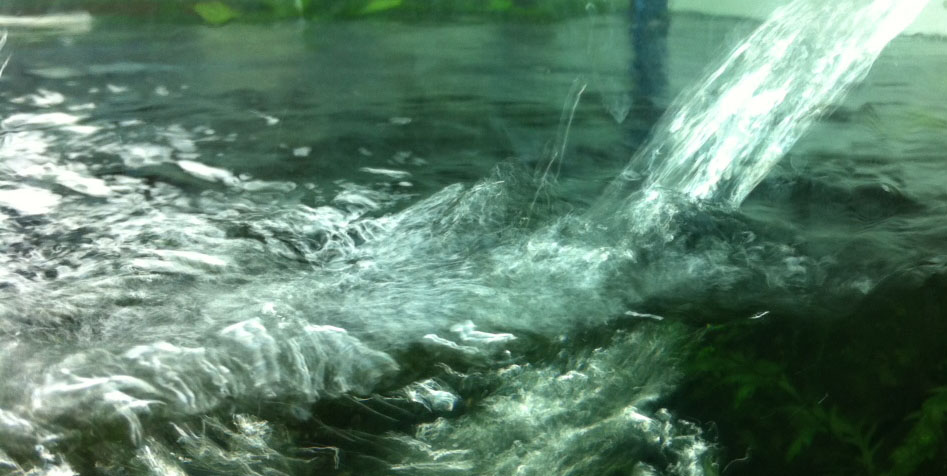 Providing good water flow is a major factor in maintaining a healthy fresh water aquarium. Without a good flow of water, problems will arise and a breakdown in the balance of the eco-system will follow.
Providing good water flow is a major factor in maintaining a healthy fresh water aquarium. Without a good flow of water, problems will arise and a breakdown in the balance of the eco-system will follow.
Inadequate water flow can result in a stagnant tank that reduces the immunity of your fish, requires more maintenance and looks sub par. Blasting your tank with excessive pressure from a stronger than necessary pump means stressed out and potentially injured fish. Some fish have delicate fins and a faster flow may damage them. Plants too can also be damaged from this faster water flow.
When deciding on a filter, the flow rate should be at the very least 3x the volume of aquarium water passing through it per hour. This is measured in litres per hour (lph). So for a 300 litre tank, there should be 900 litres passing through the filter per hour. Anywhere up to 8x the volume of water is recommended.
Your main aim is to have a consistent flow that minimizes ‘dead spots’, meaning every area of your tank is allowing water to flow through it. This will help carry the oxygen through the water for your fish to breathe and aerate the tank for beneficial bacteria to thrive in. It will also circulate nutrients and allow for easier filtration of debris and waste. If necessary with intricately designed or significantly larger tanks, a 2nd pump may be the best option to go with. Also good water flow is essential for keeping temperature consistent throughout the tank. This will avoid any hot or cold spots in the aquarium.
Keep in mind vibration is magnified significantly underwater. A consistent movement of water is great at masking active fish that can be disruptive / irritating to another more sensitive / docile species, sharing the same tank.
Along with better water flow, additional aeration may be needed. The bubbles coming from your air pump do not supply oxygen to the water itself but help with agitating the surface to allow more oxygen to enter the aquarium.
Oxygen enters the water through its surface and the water releases carbon dioxide as it does so. It’s important to always agitate the surface of the water to provide enough aeration. As mentioned previously, this not only helps the beneficial bacteria, but also provides more oxygen for happier, healthier fish to thrive, not just survive. A lot of filters are pretty good at providing enough aeration alone, but if you heavily stock your aquarium with fish then a filter by itself may not be enough and you will have to add extra oxygen. If you see your fish hanging or gasping at the water’s surface this is an indicator to increase the aeration supply to the water or add more water flow to disrupt the surface.
Also when adding medications to the water, more aeration is needed, as these chemicals often reduce the amount of oxygen in the tank, affecting your fish, bacteria and plants.
Temperature plays a major role when it comes to aeration. At higher temperatures, water has a lesser ability to retain oxygen. With colder water oxygen dissolves more readily. Unless living in an exceptionally warm environment, this usually isn’t a cause for concern.
For heavily planted tanks, turn off your air pump during the day and only put it on at night. In the day during the photosynthesis process, plants convert CO2 to O2 leaving plenty of oxygen in the aquarium. At night, plants increase their oxygen uptake and pause CO2 absorption. This reduces the amount of oxygen beneficial bacteria use to continually thrive and also limits the amount left over for your fish. In saying this there are plenty of people that don’t turn on their air at night. The aim is to maximize the use of oxygen to keep a healthy balance in the aquarium. It is advisable to observe your fish regularly and make note of any behavioral changes.
Your aquarium will be dependent on the filter and pump you choose. With such an extensive variety of fish and plants to choose from, the best way to establish your thriving aquarium, is to find out the natural environment they originate from. This will allow you to recreate their most ideal conditions and maximize the visual aesthetics of the aquarium. Make sure to purchase a filter, power head or air pump that is suited for the size of your tank. When purchasing, make sure to look on the side of the box for information relating to your specific tank requirements. Alternatively, you can always ask your retail provider.
